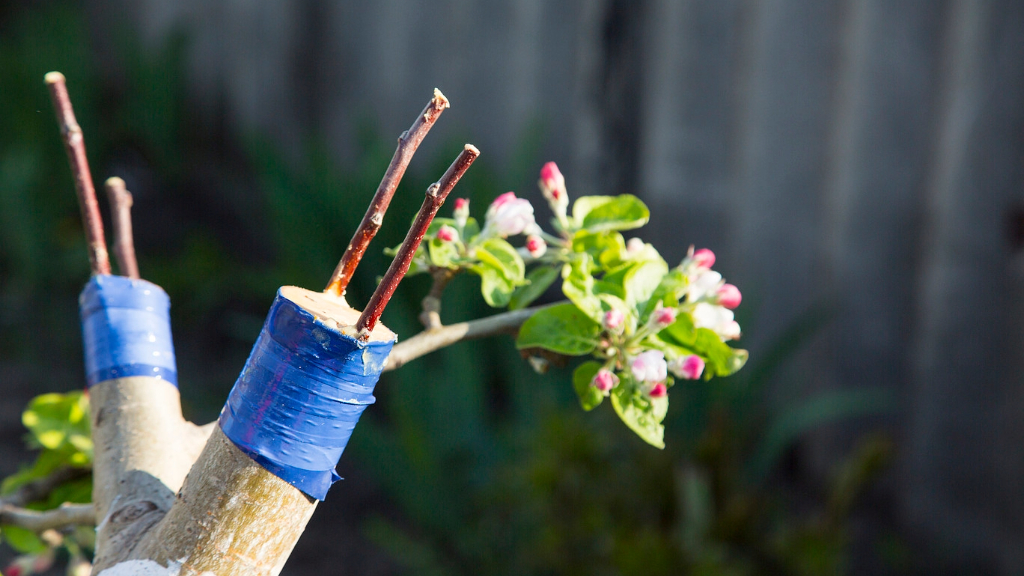Tree of 40 Fruit: A Delicious Intersection of Art and Agriculture

The fruits of Sam Van Aken's labor are beautiful and delicious. The artist and university professor who grew up on a farm is disrupting environmental art and agriculture with his Tree of 40 Fruit. Part artwork, part research, and part conservation, Van Aken's initial experiment in grafting has now blossomed into more than 50 living sculptures across the country.
Each Tree of 40 Fruit is a single grafted tree that grows forty different types of heirloom and antique stone fruit from peaches, plums, apricots to nectarines and cherries. Bursting with stunning blossoms in a kaleidoscope of variegated pink, white, and crimson tones throughout spring, and bearing a multitude of fruit in summer, these trees are not only gorgeous, they deliver the goods.
Children's Discovery Museum of San Jose, one of the largest and most respected youth museums in the nation, is home to the only public Tree of 40 Fruit on the West Coast. This Tree of 40 Fruit will be the centerpiece of the museum's new outdoor learning environment, Bill's Backyard: Bridge to Nature, scheduled to open October 2017. The tree will feature heirloom stone fruit varieties historically from Santa Clara County, once known as the Valley of Heart's Delight for its rich abundance of fruit orchards. As the tree matures it will be a part of the museum's environmental programs where children can learn about the area's rich farming history and how the fruit they enjoy reaches their lunch boxes.
August 17, 2016 was the first round of grafting. There will be two more, with each round spaced one year apart.
Someday, thanks to artist Sam Van Aken, Children's Discovery Museum's Tree of 40 Fruits will look like this when it blooms in the spring.
"While our region is now known as Silicon Valley for its technological innovations, we think it's important to help children make connections with our agricultural history, how food is grown, and healthy food choices," said Marilee Jennings, executive director of Children's Discovery Museum of San Jose. "Who knows, we may also inspire the next environmental artist." By identifying cultivars historically grown in a region, Van Aken finds forgotten fruits in local orchards, grafting them onto the Tree of 40 Fruit to preserve varieties not found commercially. For the museum's tree, he worked with legendary orchardist Andy Mariani of Morgan Hill, California, and California Rare Fruit Growers, Inc. to source varieties grown in Santa Clara Valley, perhaps the most important stone fruit-growing region in the United States. [caption id="attachment_15604" align="aligncenter" width="400"]
Tree of 40 Fruit this March, 2017, waiting to be planted in Bill's Backyard: Bridge to Nature[/caption] "It is extraordinary to work in the Santa Clara Valley with growers and a culture that supports the preservation of these heirloom fruits, said Sam Van Aken, artist. Van Aken pruned and grafted scion wood for the first time in August 2016 and again in January to bud. The tree has already bloomed delicate white and pink flowers and is on track to produce its first harvest in summer of 2018 with a full bounty in 2020.
Gardening tips, videos, info and more delivered right to your inbox!
Sign up for the Gardening Know How newsletter today and receive a free copy of our e-book "How to Grow Delicious Tomatoes".
Graft is Good: Sam's Five Steps to a Successful Graft
Timing is everything for a successful graft.
1. Collect your scion wood when the tree is dormant and store the scion wood in sealed plastic bags with a damp cloth in the bottom.
2. It's best to store the scion wood in a designated refrigerator, but if that isn't feasible; don't store it in a refrigerator with other fruits or vegetables. The off-gassing will contaminate the stock.
3. It's then a matter of waiting until the tree goes into delayed dormancy. Typically, I follow the advice that was passed onto me and wait until the leaves are the size of a "mouse's ear."
4. For summer budding, collect bud wood from the current year's growth. I collect 12-18" sections from the inner canopy of the tree that measures 5/16" in diameter. Burwood desiccates quickly - use the buds in the middle of the branch.
5. When trimming the leaves, keep the petiole, since it provides a handle to hold while budding. Although I've kept bud wood for up to four days in a refrigerator, the sooner you use it, the better your chances are for a successful graft. Sam Van Aken Artist Marilee Jennings Executive Director Children's Discovery Museum of San Jose
-
 Terrifically Tubular Flowers For Hummingbirds: 9 Tube-Flowered Plants To Attract Hummers
Terrifically Tubular Flowers For Hummingbirds: 9 Tube-Flowered Plants To Attract HummersGrowing tubular flowers for hummingbirds helps you create the optimum feeding conditions for your winged friends. Here are nine tubed delights for hummers
By Tonya Barnett
-
 How To Grow Hydroponic Tomatoes For Fresh Indoor Harvests – No Soil Required
How To Grow Hydroponic Tomatoes For Fresh Indoor Harvests – No Soil RequiredLearning how to grow tomatoes in water is easy and allows you to harvest fresh-home-grown produce in every season without any mess.
By Ellen Wells